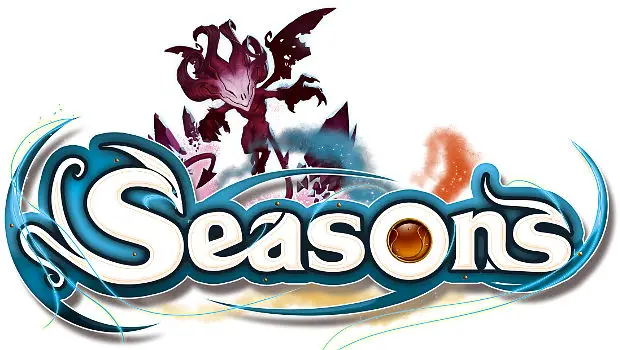C20H25N30 — lysergic acid diethylamide. LSD. Acid.
Back in the trippy days of LP records, half the experience of visiting a music store was found in the panoply of colorful covers protecting all that cool 12-inch vinyl. Then came the CD, and that big, bold blast of illustrated magic vanished into the ether.
Today, the most common board game box runs about the same size as that vintage LP. Which is why I had flashbacks to Yes album covers by Roger Dean when I first spotted the near-hallucinatory eye candy that is designer Régis Bonnessée’s hit card game, Seasons.
Like wow, man. Mind blown. No chemical assistance necessary.
This is not to say that neither alchemy nor arcane concoctions exist in the beautiful Seasons, for the premise is a three-year battle of mages, their minions, and mighty magic. By channeling the elements (blue water for winter, green earth for spring, yellow fire for summer, and red air for autumn), each player’s wizard can power collected artifacts and summon devastating familiars to savage sorcerous foes.
Magic: The Gathering or Yu-Gi-Oh! players, I see your nodding heads. Yes, Seasons is what happens when a classic collectible card game (CCG) acquires a Eurogame sensibility and loses the wallet-draining downside that has reduced more than one Magic player to ramen noodles eaten in an underheated van down by the river. No collectible aspect here, just visual goodness and a vicious game.
“My god, it’s full of…cards.”
[singlepic id=17605 w=620 h=350 float=center]
- 64 energy tokens – 16 each of air, water, fire, and earth elements
- 60 power cards (numbered 1 to 30)
- 40 extended power cards (numbered 31 to 50)
- 20 seasons dice
- 16 wooden sorcerer tokens
- 8 library tokens
- 4 player game boards
- 1 game board, incorporating the year counter and season wheel
- 1 crystal track scoreboard
- 1 rulebook
At 16 pages, the Seasons rulebook appears daunting at first, but the last 6½ give overviews of each card in the game, adding additional insights on each card’s text and playability for (gratuitous) clarity’s sake. The layout of the rulebook arranges the content logically and with superior graphic design, which combine to improve understanding.
Did I mention that Seasons is one of the best looking board games ever? If you skipped the lovely prose intro to this review, I’ll repeat: This game defines the word gorgeous.
Rather than traditional Dungeons & Dragons-like artwork, the cards in Seasons look like Middle Earth meets Alphonse Mucha, with a dreamy Art Nouveau sensibility that makes them unlike any game you’ve seen. Sinewy and dream-like, the illustrations grab you and pull you into the game.
Designer Régis Bonnesée gives us 100 power cards to drive Seasons; two each of 50 kinds of magic items (purple) and familiars (orange). The cards contain the title of the card at top, along with any prestige points, which tally toward victory. The card’s cost, typically in energy types or crystals, is below the depicted artifact or familiar. Some costs scale according to the number of players. Players “summon” the cards into play, the number of cards dictated by the summoning gauge on each player’s board, and place them into their tableau.
The card text reveals how the card functions. Some cards have multiple functions, some stack, but others may force a player to choose a use. In the lower left corner of the card is its effect timing. A squat arrow means it takes effect once. An arrow in a circle means a continuing effect. A cog allows players to “tap” the card and use it. Cog cards exact some price to play each time, usually in energy.
Lastly, cards include a number at the bottom in tiny text. This allows players to find them in the rulebook for rules clarifications and also clarifies which cards work for the basic, intermediate, and advanced game.
Besides the fantastic fantastical artwork by French artist Naïade (one name only, your assurance of quality!) found on both the cardboard and cards in Seasons, I’ve never seen a set of dice as wonderful as the colorful, chunky cubes you’ll roll in this game. An inch on each side and engraved to perfection, they’ll have you cooing, “Where you been all my life, Gorgeous?”
Them bones, them bones
About those dice:
- Blue = water/winter
- Green = earth/spring
- Yellow = fire/summer
- Red = air/autumn
The 20 dice included in Seasons contain the following symbols in varying proportions:
- Energy symbols
- Numbers corresponding to crystals, the game’s victory points
- A ring that allows for converting energy into crystals
- A star for increasing the number of cards a player can summon to the tableau
- 1-3 dots, which signal how many months to advance the month/season counter on the game board
- A rectangle, which allows a player to draw a card from the draw pile
The round game board, which serves as an information source, depicts the four seasons in their colors and the three years over which the players battle, Between the year marks and month/seasons ring is a conversion table graphic for converting (AKA “transmuting”) energy into crystals.
The crystal track scoreboard uses typical Eurogame wooden cubes that correspond to player colors (using two sorcerer tokens from each player), marking 1-99, plus markers for increments of 100. The tokens mark crystals owned. At game’s end, prestige points from cards and bonus play use are included in the crystal track tally.
Player cards have numbers across the top to show the number of cards that can be in the player’s summon tableau. Below that is a 0, -5, -12, -20 prestige point penalty mark and a list of bonus actions a player can take: exchange two energy types, increase the number of cards summonable to the tableau, transmute (exchange) energy for crystals. Taking a bonus incurs an increasing penalty each time, tallied at game’s end.
Sucked dry by an Arcano Leech
[singlepic id=17603 w=620 h=350 float=center]
Seasons offers three levels of play (basic. intermediate, and advanced) based on card use. The advanced game uses all 100 cards.
Each player receives nine cards. Like the game 7 Wonders, players draft a hand by selecting a card then passing the remainder to the next player. Repeat until all cards are selected. Split the selected hand into three cards per three years, with years two and three marked with corresponding library tokens. Because effects from cards played earlier will stack as time passes, card set order matters. Some cards have repeated effects that would benefit from early play. Others play best during the end game.
Set the dice around the game board to match the season color on the game board. Dice used in each color equals player count plus one. Player one starts by rolling the dice for winter, selecting which single die to keep. In turn order, the other players choose from the remaining dice until the one extra die remains. That die’s dots determine how many months the month counter will advance, slowing or hurrying the game. Each player in turn then resolves the symbols (see above) on the die selected (though some advanced players will speed the game by resolving everyone’s turns at once).
Players roll the same color season of die unless the month counter crosses into a new season, which means rolling the next color. Each season/color of dice favors its primary element and disfavors the elemental energy of the opposing season on the game board. Good players will factor this into their initial card distribution. For instance, autumn is last, so any cards that rely heavily on air energy will be harder to play early.
When the month marker passes into the next winter, players add their next three cards to their hands. Cards from the previous year(s) remain in-hand. Getting rid of hand cards is critical, since each unplayed card at game’s end is -5 prestige points.
Summoning a card into play requires adequate oomph on the player board’s summoning gauge. A player can perform as many actions on a turn as the die, played power cards, energy, summoning gauge, and crystals permit. In addition, some cards allow a player actions on another player’s turn.
Once the 12th month of the third year passes, the game is over. All prestige points (both positive and negative) from cards and bonus use are added to the crystal tally. Highest number wins.
This card modifies that card, which modifies those three cards…
The good…
Seasons is one of the finest-looking games on the market. High-quality components only boost this. Despite these positives, the game has an affordable street price.
Best dice in a game. Period.
Core rules can be explained in less than 10 minutes–and possibly five with hardcore gamers who understand the basic mechanics underlying the game. People familiar with Magic: The Gathering or Yu-Gi-Oh! will probably like Seasons and should understand it quickly.
Not being a CCG also works in Season’s favor, with each base game (and expansion) containing the same sets of cards as any other. While basic gameplay is straightforward, the card-driven design of Seasons means no end to expandability and replayability. Expect additional dice in future expansions too.
The bad…
That positive diversity in cards carries its own weakness, though. Seasons requires players know how the cards work. It demands and rewards repeat plays. New players will do almost everything wrong that first game and will be slaughtered by—ahem—seasoned players.
Because the cards contain so many actions that chain actions, despite its simple rules, Seasons can be an in-play management nightmare. Prepare for a turn or two of analysis paralysis from each player at some point in the game. So much is happening in the player’s hand, the other player’s tableaus, and with forecasting moves and seasons, the input borders on overwhelming, especially for people who have not played the game at least a half dozen times.
Card knowledge extends to seeing an opponent’s cards. It’s hard to read card text from across the table. Knowing a card’s capability helps. Keeping track of your own cards’ capabilities is tough enough; now track the other guy’s!
Expect a LONG first or second play, especially with four players. Knowing the cards well will whittle the playing time, though. Experienced players can fly through the game, but newbies often get lost in card interactions and possibilities. Despite what the box and rules say, this isn’t a great four-player game; limit play to two or three players.
Seasons is not for the faint of heart. It can be a high-screwage game due to a large number of detrimental cards (when playing with the full deck). Often a single card can sabotage another player’s careful plans. In the case of the first session I played, an opponent’s card forced me to discard one of the two power cards foundational to my entire strategy. This happened in the first year, and I was energy poor for the rest of the game. Experience would have overcome the bad decision and subsequent need to recover, but still. Those who can’t handle getting brutalized with a devastating opponent play, this is not your game.
The ugly…
Ugly in the lovely Seasons? Yes, actually. The crystal track scoreboard gets most of the scorn.
Though the crystal track starts out with rows of numbers in increments of 10, this pattern diverges at the top, which foils a simple 10-point move by sliding up a row. In a game with such attention to design, this seems a misstep.
Don’t jar the scoreboard, either, especially if tokens are stacked because of tied scores. Given how often players will adjust scores–a nonstop process in the game that consumes more time than it should–a better scorecard is needed. Something along the line of the dial-based scorecards in King of Tokyo might make more sense.
Some fans of the game have junked the crystal track, instead using colored crystals or gems bought from a hobby store. Assign a value to each color and use the crystals like coins.
Because you need more beauty in your life
[singlepic id=17604 w=620 h=350 float=center]
In May 2013, the first expansion for Seasons arrived, Seasons: Enchanted Kingdom. It includes two each of 20 new power cards, 10 enchantment cards that modify playing conditions, 12 special ability tokens unique to each player, a first player marker, and more for $24.99 MSRP. A second expansion, Seasons: Path of Destiny, is due in March 2014.
Oh, and you can play Seasons online at BoardGameArena.com too.
A work of gaming art
Seasons’ stunning exterior hides a harridan’s heart. Build a team of familiars, toss in some magical artifacts, manage energy wisely, and drain/crush/incinerate your opponents—cackling with maniacal glee optional.
Libellud and Asmodee have a hit on their hands. People talked about the look of the game long before its release, and with the exception of the clunky scorecard, everything comes together beautifully. This is one of the best games to come to market in the last couple years.
With brain-burning tactics and strategy, beautiful components, hybrid Eurogame/Ameritrash gameplay, and unlimited replayability, Seasons is a winner in every regard and a fine addition to any gaming collection.
Game Name: Seasons
Designer: Régis Bonnessée
Publisher:Libellud (distributed by Asmodee)
Year: 2012 (Seasons: Enchanted Kingdom, 2013)
Players: 2-4
Ages: 14+
Play time: 60 minutes
Mechanics: Card drafting, Card management, Dice rolling
Weight: Medium– “Challenging, plenty to observe and manage”
MSRP: $49.99***
Freelance writer, editor, marketer, and more. Enjoy birding, geocaching, reading, drumming, and of course, board gaming.
Been playing board games since the 1960s. Have owned all the classics--Dark Tower, Bermuda Triangle, PanzerBlitz, Fireball Island, Magic Realm, and more. Got into RPGs with D&D and AD&D back in the late 1970s.
Today, I'm primarily a Eurogamer, and I play a little Pathfinder. Favorite games include: Tzolkin: The Mayan Calendar, Airlines Europe, 7 Wonders, Power Grid, Lords of Waterdeep, Seasons, Puerto Rico, and Hanabi.

Seasons is a stunning-looking card game driven by some of the coolest dice in gaming. It marries those dice to a battling mages theme reminiscent of Magic: The Gathering or Yu-Gi-Oh!, but without the wallet-draining collectible craziness. Seasons is those games given a Eurogame sensibility, and it all works beautifully.
PROS
- Gorgeous
- Simple core rules
- Unlimited expandability and replay value
CONS
- Frustrating score tracking
- Demands card knowledge and multiple plays
- Initial plays may run long past suggested play time
See below for our list of partners and affiliates:

























